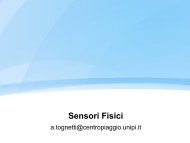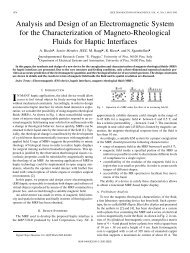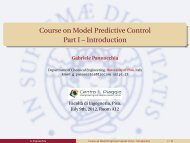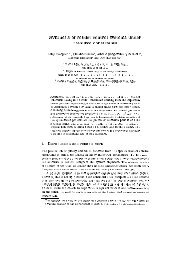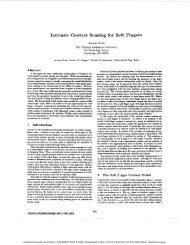Design and Control of an Air-Jet Lump Display - Centro E Piaggio
Design and Control of an Air-Jet Lump Display - Centro E Piaggio
Design and Control of an Air-Jet Lump Display - Centro E Piaggio
Create successful ePaper yourself
Turn your PDF publications into a flip-book with our unique Google optimized e-Paper software.
(a) Casing (b) Continuous Disk (c) Discrete Disk (d) Plug (e) Casing LidFigure 2: Components <strong>of</strong> the pneumatic air-jet lump display. (a) Casing: Encloses the servo motor <strong><strong>an</strong>d</strong> receives compressed air from thepressure regulator. (b,c) Continuous <strong><strong>an</strong>d</strong> discrete aperture disks: Aperture disks sit flush with the casing top surface <strong><strong>an</strong>d</strong> fix to the servo motorshaft. Servo-initiated rotation <strong>of</strong> disks ch<strong>an</strong>ges the effective aperture size. (d) Plug: Stabilizes the servo inside the casing, preventing unw<strong>an</strong>tedaxial shifts. (e) Casing Lid: Seals the display using a rubber o-ring <strong><strong>an</strong>d</strong> four binding sites. Has a hole on the top through which the air-jet escapes.flexible sheet dampens the noticeable effects <strong>of</strong> ch<strong>an</strong>ging controlparameters. As a result, we elected to design a display with theintention <strong>of</strong> stimulating directly on the surface <strong>of</strong> the skin.In its simplest form, our air-jet display (Fig. 1a) c<strong>an</strong> be described<strong><strong>an</strong>d</strong> controlled using two degrees <strong>of</strong> freedom (Fig. 1b): (1) the supplypressure provided to the display, <strong><strong>an</strong>d</strong> (2) the size <strong>of</strong> the aperturethrough which the air escapes. We hypothesize that the aperturesize <strong><strong>an</strong>d</strong> the air pressure will correspond in some way to theperceived size <strong><strong>an</strong>d</strong> stiffness <strong>of</strong> the lump, respectively. Preliminarypsychophysical evaluation has focused on the just noticeable difference(JND) <strong>of</strong> pressure perception [1]. Unlike balloon-type lumpdisplays [4] that c<strong>an</strong> not effectively decouple lump size <strong><strong>an</strong>d</strong> stiffness,the air-jet display gives independent control over perceivedlump size (aperture size) <strong><strong>an</strong>d</strong> stiffness (air pressure).3 DEVICE DESIGN AND CONTROLThe air-jet display is comprised <strong>of</strong> five main parts: a main outer casing(Fig. 2a), a circular disk to control aperture size (Figs. 2b or 2c),a small servo motor to rotate the aperture disk (not shown), a stabilizingplug to secure the motor <strong><strong>an</strong>d</strong> reduce unw<strong>an</strong>ted motion <strong>of</strong> thedisk during operation (Fig. 2d), <strong><strong>an</strong>d</strong> the casing lid (Fig. 2e), whichseals the device. All components shown in Fig. 2 were designedusing ProEngineer (PTC, Needham, MA USA), <strong><strong>an</strong>d</strong> m<strong>an</strong>ufacturedusing a u-Print rapid prototyping 3D printer (Dimension, Inc., EdenPrairie, MN USA). The uPrint uses ABSplus TM thermoplastic asits building material (tensile strength <strong>of</strong> 5,300 psi). All designedcomponents underwent several iterations, each aimed at reducingthe size <strong><strong>an</strong>d</strong> weight <strong>of</strong> the display, as well as minimizing air leaks.Aperture size is controlled using a TowerPro MG-90 servo motor(Tower-Pro Electron Co. Ltd, Shenzhen, China), which sits centrallyin the casing <strong><strong>an</strong>d</strong> rotates the aperture disk to a desired positionto ch<strong>an</strong>ge the effective aperture size. <strong>Air</strong> pressure is controlledusing <strong>an</strong> electronic pneumatic regulator (SMC-ITV2031-21N2L4,SMC Corporation, Noblesville, IN, USA) which provides step-lesscontrol <strong>of</strong> air pressure (0.05 - 0.5 MPa) proportional to <strong>an</strong> electricalsignal (0 - 5 V), with a maximum flow rate <strong>of</strong> 1500 L/min. The design<strong><strong>an</strong>d</strong> purpose <strong>of</strong> each component <strong>of</strong> the pneumatic air-jet lumpdisplay is described in greater detail in the sections that follow.3.1 Discrete Aperture DiskSince the display was designed specifically for single finger stimulation,we needed to carefully select a fixation dist<strong>an</strong>ce from theoutlet, <strong><strong>an</strong>d</strong> aperture sizes that keep the jet diameter smaller th<strong>an</strong> thewidth <strong>of</strong> the index fingerpad. <strong>Jet</strong> theory explains that for <strong>an</strong>y jetpenetrating a fluid <strong>of</strong> the same density (e.g. air), the jet envelopeadopts a conical shape (Fig. 3), <strong><strong>an</strong>d</strong> the opening <strong>an</strong>gle <strong>of</strong> the jet enveloperemains const<strong>an</strong>t (11.8 ◦ ) regardless <strong>of</strong> aperture diameter ordischarge speed [5]. The jet radius (R) at a given dist<strong>an</strong>ce from theoutlet (X 1 ) originating from <strong>an</strong> aperture <strong>of</strong> diameter (d) is given bythe equationFigure 3: A typical air-jet opening envelope develops in a conicalshape with a const<strong>an</strong>t coefficient <strong>of</strong> proportionality <strong>of</strong> 11.8 ◦ . The jetradius (R) is a function <strong>of</strong> the dist<strong>an</strong>ce from the outlet (x 1 ) <strong><strong>an</strong>d</strong> theaperture diameter (d).R(X 1 ,d) = t<strong>an</strong>(11.8 ◦ )[X 1 + 5 ]2 dWe fixed X 1 to be 14 mm then identified the largest aperture diameter(d) which kept the jet radius (R) near 5 mm. This resulted ina maximum aperture diameter <strong>of</strong> d = 3.97 mm. We selected 4.5 mmas our maximum aperture size, which results in a jet diameter <strong>of</strong>≈ 10.5 mm, less th<strong>an</strong> the width <strong>of</strong> the average index fingerpad.We selected eight aperture diameters r<strong>an</strong>ging from 1.0 mm to4.5 mm, equally spaced by 7/16 mm, except between the smallesttwo apertures, where this space is doubled. The center <strong>of</strong> eachaperture was fixed radially 15 mm from the center <strong><strong>an</strong>d</strong> arr<strong>an</strong>ged circumferentiallyaround the disk such that the area <strong>of</strong> the aperturesincreased linearly with rotation <strong>an</strong>gle (Fig. 5). The <strong>an</strong>gular placement<strong>of</strong> each aperture on the discrete disk is given by(1)θ = γ ∆θ + θ min , (2)where γ <strong><strong>an</strong>d</strong> ∆θ are determined entirely from the minimum (r min )<strong><strong>an</strong>d</strong> maximum (r max ) aperture size at θ min = 10 ◦ <strong><strong>an</strong>d</strong> θ max = 180 ◦ ,respectively:γ = r2 aperture − r 2 minr 2 max − r 2 min∆θ = θ max − θ min3.2 Continuous Aperture Disk(3a)(3b)In addition to the discrete aperture disk, we evaluated <strong>an</strong> alternative“continuous” aperture disk by creating a circumferential slotthat gradually ch<strong>an</strong>ges width around the circumference <strong>of</strong> the disk(Fig. 4a). The outer (r o ) <strong><strong>an</strong>d</strong> inner (r i ) curves defining the ch<strong>an</strong>gingshape <strong>of</strong> the continuous slot are defined byr o,i (θ) = r ±√(r max ) 2 (θ − θ o ) − (r min ) 2 (θ − θ f ), (4)(θ f − θ o )
(a)(b)Figure 4: (a) Calculation <strong>of</strong> effective area <strong>of</strong> continuous disk. Radii r min <strong><strong>an</strong>d</strong> r max are the radii <strong>of</strong> the smallest <strong><strong>an</strong>d</strong> largest circles that c<strong>an</strong> beinscribed at slot ends. The center <strong>of</strong> the smallest circle is at (r,θ o ), <strong><strong>an</strong>d</strong> the center <strong>of</strong> the largest circle is at (r,θ f ) in polar coordinates. Circler b represents the aperture size on the casing through which the air-jet interfaces with the continuous disk slot. Radii r o (θ) <strong><strong>an</strong>d</strong> r i (θ) representthe dist<strong>an</strong>ce from the disk center to the outer <strong><strong>an</strong>d</strong> inner curves, respectively, at a given θ. A b represents the effective area <strong>of</strong> the intersectionbetween the continuous slot <strong><strong>an</strong>d</strong> the area <strong>of</strong> the base aperture. (b) Effective area <strong>of</strong> continuous disk aperture at varying values <strong>of</strong> θ.function is illustrated clearly in Fig. 4b in the disk marked by 10 ◦ .When the continuous disk reaches 18 ◦ , the endpoint <strong>of</strong> the smallend <strong>of</strong> the slot enters within the perimeter <strong>of</strong> the base aperture,causing a ch<strong>an</strong>ge in the relationship between area <strong><strong>an</strong>d</strong> <strong>an</strong>gle. Thepiecewise equation provides a me<strong>an</strong>s to control the rotation <strong>of</strong> thedisk in a linear fashion in s<strong>of</strong>tware. The user inputs a desired area,<strong><strong>an</strong>d</strong> the s<strong>of</strong>tware calculates the corresponding <strong>an</strong>gular position.Figure 5: Effective aperture area vs. <strong>an</strong>gle <strong>of</strong> rotation for the discrete<strong><strong>an</strong>d</strong> continuous aperture disks. Discrete apertures display a linearrelationship between aperture area <strong><strong>an</strong>d</strong> <strong>an</strong>gular placement on thedisk. The continuous aperture slot has two sections with differingbehaviors: A linear behavior is observed up to θ = 18 ◦ , after whichthe curve c<strong>an</strong> be expressed using a power relation.where r max <strong><strong>an</strong>d</strong> r min refer to the radius <strong>of</strong> the circle that c<strong>an</strong> be inscribedat the large <strong><strong>an</strong>d</strong> small ends <strong>of</strong> the slot, respectively. Wecomputed the area <strong>of</strong> the intersection (A b ) between the base aperture(r b ) <strong><strong>an</strong>d</strong> the continuous slot (r o,i (θ)) for all values <strong>of</strong> θ. As theslotted disk is rotated with respect to the base aperture, the effectivearea ch<strong>an</strong>ges (Fig. 4b). The radii r min <strong><strong>an</strong>d</strong> r max were set so that theeffective intersection area at minimum <strong><strong>an</strong>d</strong> maximum <strong>an</strong>gular disk<strong>an</strong>gles were approximately equal to the areas at the endpoints <strong>of</strong>the discrete disk. Unlike the discrete disk which ch<strong>an</strong>ges aperturearea linearly with θ, the continuous disk exhibits a more complexbehavior. Fig. 5 shows the effective aperture area (A b ) as a function<strong>of</strong> disk rotation (θ). This relationship is described by the piecewisefunctionA b ={ aθ − b if θ ≤ 18 ◦cθ n if θ > 18 ◦ (5)with a linear fit for small θ, <strong><strong>an</strong>d</strong> a power function fit for larger θ.Coefficients for equation (5) are shown in Fig. 5. The piecewise3.3 Casing <strong><strong>an</strong>d</strong> Servo MotorThe servo motor rotating the aperture disks has a rotation r<strong>an</strong>ge <strong>of</strong>170 ◦ , a maximum speed <strong>of</strong> 545 ◦ per second, <strong><strong>an</strong>d</strong> 31 oz-in <strong>of</strong> torque.A servo motor was used instead <strong>of</strong> other motor types because servosproduce a relatively high amount <strong>of</strong> torque for their small size <strong><strong>an</strong>d</strong>weight. We use a Phidgets Adv<strong>an</strong>ced Servo 1066 servo controller(Phidgets, Inc., Calgary, Alberta, C<strong>an</strong>ada) to communicate with theservo. Servo motor position is controlled by providing pulse widths<strong>of</strong> a specified duration, which map linearly to shaft <strong>an</strong>gle. Minimum<strong><strong>an</strong>d</strong> maximum pulse widths used to control the <strong>an</strong>gular position<strong>of</strong> the servo shaft were 600 <strong><strong>an</strong>d</strong> 2350 µs, respectively.The casing houses the servo motor internally, <strong><strong>an</strong>d</strong> serves as amedium for tr<strong>an</strong>sferring pressurized air from the pressure regulatorthrough the aperture disk. <strong>Air</strong> is fed from the pressure regulatorthrough 6.4 mm outer diameter (O.D.) polyureth<strong>an</strong>e tubing, whereit connects to the underside <strong>of</strong> the casing by me<strong>an</strong>s <strong>of</strong> a push-toconnectfitting. The air passes through the aperture disk <strong><strong>an</strong>d</strong> exitsthrough the 5 mm diameter hole on the casing lid. The displaycontains two Buna-N O-rings (each 2 mm thick) designed to sealthe system <strong><strong>an</strong>d</strong> force all pressurized air through the aperture disk(Fig. 6, bottom). One O-ring (11 mm O.D.) is placed around thehole in the lid casing <strong><strong>an</strong>d</strong> seals between the lid <strong><strong>an</strong>d</strong> aperture disk,<strong><strong>an</strong>d</strong> the other (44 mm O.D.) placed around the circumference <strong>of</strong> thelid, sealing the lid <strong><strong>an</strong>d</strong> casing. The seals are compressed by screwingthe lid to the casing with four small screws. Both O-rings fitinto circumferential grooves <strong>of</strong> rect<strong>an</strong>gular cross-section, <strong><strong>an</strong>d</strong> weredesigned to provide 25% compression to the O-ring. This allowssufficient compression to provide effective air sealing without increasingthe friction level on the disk beyond the ability <strong>of</strong> the servomotor to rotate. Each display weighs 53 grams.4 DEVICE CHARACTERIZATIONWe used <strong>an</strong> array <strong>of</strong> capacitive tactile sensors (DigiTacts, PressurePr<strong>of</strong>ile Systems, Los Angeles, CA USA) to qu<strong>an</strong>titatively measurethe output <strong>of</strong> the air-jet lump display using both discrete <strong><strong>an</strong>d</strong> continuousaperture disks. The tactile sensor array is comprised <strong>of</strong> threesmaller sensors arr<strong>an</strong>ged contiguously to form a 6 × 12 array <strong>of</strong>
Figure 7: (Left) Tactile sensors forming the sensing array; the areaencircled by the red box represents the location <strong>of</strong> the sensing elements.(Right) Experimental setup used to measure the peak pressure<strong>of</strong> the impinging air-jet.Figure 6: Pneumatic air-jet lump display. (Left) The continuous <strong><strong>an</strong>d</strong>discrete display devices are mounted on the display unit. (Right)Electronics box houses the pressure regulator, servo controllerboard, <strong><strong>an</strong>d</strong> DAQ breakout board. (Bottom) Two sealing rings integratedinto the bottom side <strong>of</strong> the opened casing lid.(a) Discrete Aperture Disktactile sensing elements (Fig. 7, left). The display was inverted <strong><strong>an</strong>d</strong>placed 14 mm above the sensors with the output centered over thetactile sensor array (Fig. 7, right).For the discrete disk, each aperture size (1.9, 2.3, 2.8, 3.2, 3.8,4.1, <strong><strong>an</strong>d</strong> 4.5 mm) was measured at each supply pressure level (10,20, 30, <strong><strong>an</strong>d</strong> 40 psi) first in ascending, then descending order. Priorto each measurement pair (aperture size, pressure), the pressure wasset to zero <strong><strong>an</strong>d</strong> the sensors were baselined to minimize sensor noise.Each measurement consisted <strong>of</strong> 150 samples <strong>of</strong> tactile data. The1.0 mm aperture size was not used since the small diameter createda large resist<strong>an</strong>ce which compromised the seals <strong>of</strong> the display.For the continuous disk, we measured data at the <strong>an</strong>gles wherethe effective area <strong>of</strong> the continuous slot matched the areas <strong>of</strong> the discreteapertures. Those values <strong>of</strong> θ were obtained from Equation (5).At each measurement <strong>an</strong>gle, data was recorded in the same m<strong>an</strong>neras the discrete case. For both discrete <strong><strong>an</strong>d</strong> continuous disks, supplypressures up to 46 psi were attainable.5 RESULTS AND DISCUSSION5.1 Tactile Images <strong><strong>an</strong>d</strong> Pressure DistributionsAll 150 samples from a single measurement pair are averaged t<strong>of</strong>orm a “tactile image”, where the average value for each sensorelement is plotted in the same spatial configuration as the actualtactile sensor. Each tactile image is then processed using bilinearinterpolation. Fig. 8 shows tactile images recorded at a const<strong>an</strong>tsupply pressure <strong>of</strong> 40 psi for both discrete (Fig. 8a) <strong><strong>an</strong>d</strong> continuous(Fig. 8b) aperture disks. Tactile images for smaller supply pressuresare not shown. The ch<strong>an</strong>ge in size <strong>of</strong> the air-jet pressure pr<strong>of</strong>ile <strong>of</strong>the discrete disk apertures is clearly visible. Additionally, tactileimages show circular pr<strong>of</strong>iles which reflect the circular nature <strong>of</strong>the aperture. One consequence <strong>of</strong> using a continuous slot is that theshape <strong>of</strong> the effective aperture becomes increasingly non-circular asthe disk rotates toward the smaller end <strong>of</strong> the slot. This results in aslightly different pressure output pr<strong>of</strong>ile that c<strong>an</strong> be seen in Fig. 8b.The air-jet lump display is a type <strong>of</strong> short impingement jet, whichare known to exhibit a Gaussi<strong>an</strong> pressure pr<strong>of</strong>ile upon impingement[12]. For each tactile image, we identified the row <strong>of</strong> data that(b) Continuous Aperture DiskFigure 8: Tactile images recorded at 40 psi supply pressure. (a) Tactileimages from discrete aperture disk. The aperture size r<strong>an</strong>gesfrom 1.9mm (left) to 4.5mm (right). (b) Tactile images from continuousaperture disk. Area <strong>of</strong> effective aperture for each image matchesthe area <strong>of</strong> the equivalent discrete aperture.contained the maximum pressure value, <strong><strong>an</strong>d</strong> fit a Gaussi<strong>an</strong> to thedata. Fig. 9 shows the Gaussi<strong>an</strong> fits to the tactile data <strong><strong>an</strong>d</strong> illustratesthe ch<strong>an</strong>ging shape <strong>of</strong> the pressure pr<strong>of</strong>ile at every combination <strong>of</strong>aperture size <strong><strong>an</strong>d</strong> supply pressure. The maximum <strong>of</strong> the Gaussi<strong>an</strong>curves are not always at the center <strong>of</strong> the x-axis, in part because <strong>of</strong>discretization <strong><strong>an</strong>d</strong> also because the aperture was not centered perfectlyon top <strong>of</strong> the sensors.Although subjective, the authors feel that the output <strong>of</strong> the displaygenerates a compelling lump percept as the skin <strong>of</strong> the fingerpadis indented in a spherical pattern. Peak pressure is consistentlyperceived at the center <strong>of</strong> the stimulus. The air-jet displayoutput feels slightly less spherical for the smaller slot size <strong>of</strong> thecontinuous aperture disk, but complete psychophysical tests will berequired to evaluate the perceptual extents <strong>of</strong> the display more rigorously.5.2 Aperture-Pressure CurvesWe extracted the maximum pressure value from the tactile imageproduced by each aperture <strong><strong>an</strong>d</strong> supply pressure combination.These “peak pressure values” for discrete (Fig. 10a) <strong><strong>an</strong>d</strong> continuous(Fig. 10b) aperture disks show similar magnitudes, but slightly differentbehavior with varying aperture size. For both aperture disks,P1-P4 represent supply pressures <strong>of</strong> 10-40 psi, respectively. These
(a) DiscreteFigure 9: Pressure pr<strong>of</strong>iles for all supply pressures <strong><strong>an</strong>d</strong> aperturesizes. Data points represent the row <strong>of</strong> recorded tactile sensor valuessp<strong>an</strong>ning the sensor which contained the peak pressure value.Red dashed lines are Gaussi<strong>an</strong> fits for discrete disk tactile data.plots represent the maximum output pressure that c<strong>an</strong> be achievedacross the r<strong>an</strong>ge <strong>of</strong> aperture sizes <strong><strong>an</strong>d</strong> supply pressures. The peakpressure is almost const<strong>an</strong>t for the lowest supply pressure (10 psi)across all apertures. Smaller apertures give a lower peak pressureth<strong>an</strong> the larger apertures. Sharper ch<strong>an</strong>ges in peak pressure valuesare observed between apertures 1.9 mm <strong><strong>an</strong>d</strong> 3.2 mm. The smallestaperture (1.0 mm) data was again omitted from the plot for reasonsdescribed previously.6 CONCLUSIONS AND FUTURE WORKWe have designed <strong>an</strong> air-jet lump display capable <strong>of</strong> displayinglumps with different sizes <strong><strong>an</strong>d</strong> pressures by modulating the aperturesize <strong><strong>an</strong>d</strong> supply pressure, respectively. We have collected tactiledata using capacitive pressure sensors in order to qu<strong>an</strong>titativelycharacterize the output <strong>of</strong> the display. Tactile data shows that thedisplay is capable <strong>of</strong> altering the air-jet pressure, as well as the size<strong>of</strong> the impinging air-jet. Additionally, initial evaluations <strong>of</strong> the displayoutput, although subjective, have yielded compelling spherical,“lump-like” percepts. The accomp<strong>an</strong>ying videos illustrate thedisplay mech<strong>an</strong>ism <strong><strong>an</strong>d</strong> the accomp<strong>an</strong>ying tactile data (both continuous<strong><strong>an</strong>d</strong> discrete) as the aperture disk is rotated.Future work will focus on rigorous psychophysical tests whichdetermine the just noticeable difference (JND) for supply pressure<strong><strong>an</strong>d</strong> aperture size. This will allow additional tuning <strong>of</strong> control algorithms,<strong><strong>an</strong>d</strong> increase the accuracy <strong>of</strong> the percepts produced from thedisplay. One drawback <strong>of</strong> <strong>an</strong> air-jet display is the noise it produces,especially when impinging on a surface or at higher supply pressures.There are measures which c<strong>an</strong> be taken to reduce the noise(e.g. plastic box, foam), although noise may be more or less <strong>of</strong> aconcern depending on the application in which the air-jet display isused. Additionally, the size <strong>of</strong> the device could be reduced from itscurrent state. Since pressure regulation occurs upstream, the onlymech<strong>an</strong>ical component <strong>of</strong> the display is the servo used to ch<strong>an</strong>ge theaperture size. We would like to explore other novel mech<strong>an</strong>isms toch<strong>an</strong>ge the aperture size which could potentially occupy much lessspace <strong><strong>an</strong>d</strong> therefore make the display much smaller.A pneumatic-based approach is a largely unexplored <strong><strong>an</strong>d</strong>untested strategy for a targeted haptic display task such as lumprendering in RMIS applications. As we underst<strong><strong>an</strong>d</strong> more about theair-jet stimulus, how it is controlled <strong><strong>an</strong>d</strong> perceived, it c<strong>an</strong> be used inapplications where the goal is to display a spherical shape to fingerpad.Additionally, <strong>an</strong> array <strong>of</strong> air-jets c<strong>an</strong> be used to display largespatial pressure variations.ACKNOWLEDGEMENTSThis work was supported in part by the US Army Medical Research<strong><strong>an</strong>d</strong> Material Comm<strong><strong>an</strong>d</strong> under Contract No. W81XWH-11-(b) ContinuousFigure 10: Tactile sensor peak pressure values recorded at eachaperture <strong><strong>an</strong>d</strong> supply pressure. Supply pressures P1-P4 correspondto 10-40 psi, respectively. (a) Discrete disk peak pressure values (b)Continuous disk peak pressure values.C-0050, Johns Hopkins University, <strong><strong>an</strong>d</strong> a National Science FoundationGraduate Research Fellowship.REFERENCES[1] M. Bi<strong>an</strong>chi, J. C. Gwilliam, A. Degirmenci, <strong><strong>an</strong>d</strong> A. Okamura. Characterization<strong>of</strong> <strong>an</strong> <strong>Air</strong> <strong>Jet</strong> Haptic <strong>Lump</strong> <strong>Display</strong>. In Proc. Int’l Conf. <strong>of</strong>the IEEE Engineering in Medicine <strong><strong>an</strong>d</strong> Biology Society, pages 3467–3470, 2011.[2] L. Boguslawski <strong><strong>an</strong>d</strong> C. O. Popiel. Flow structure <strong>of</strong> the free roundturbulent jet in the initial region. Journal <strong>of</strong> Fluid Mech<strong>an</strong>ics,90(03):531, 2006.[3] V. G. Chouvardas, A. N. Miliou, <strong><strong>an</strong>d</strong> M. K. Hatalis. Tactile displays:Overview <strong><strong>an</strong>d</strong> recent adv<strong>an</strong>ces. <strong>Display</strong>s, 29(3):185–194, 2008.[4] M. Culjat, C. H. King, M. Fr<strong>an</strong>co, J. Bisley, W. Grundfest, <strong><strong>an</strong>d</strong>E. Dutson. Pneumatic balloon actuators for tactile feedback in roboticsurgery. Industrial Robot, 35(5):449–455, 2008.[5] B. Cushm<strong>an</strong>-Roisi. Turbulent <strong>Jet</strong>s. In Environmental Fluid Mech<strong>an</strong>ics,chapter 9. John Wiley <strong><strong>an</strong>d</strong> Sons, H<strong>an</strong>over, New Hampshire, 2010.[6] R. Howe, W. Peine, D. K<strong>an</strong>tarinis, <strong><strong>an</strong>d</strong> J. Son. Remote palpationtechnology. IEEE Engineering in Medicine <strong><strong>an</strong>d</strong> Biology Magazine,14(3):318–323, 1995.[7] K. Inoue, F. Kato, <strong><strong>an</strong>d</strong> S. Lee. Haptic device using flexible sheet<strong><strong>an</strong>d</strong> air jet for presenting virtual lumps under skin. In ProceedingsIEEE/RSJ Int’l Conf. on Intelligent Robots <strong><strong>an</strong>d</strong> Systems, pages 1749–1754, 2009.[8] J. Killebrew, S. Bensmaia, J. Damm<strong>an</strong>n, P. Denchev, S. Hsiao,J. Craig, <strong><strong>an</strong>d</strong> K. Johnson. A dense array stimulator to generate arbitraryspatio-temporal tactile stimuli. Journal <strong>of</strong> Neuroscience Methods,161(1):62–74, 2007.[9] M. V. Ottermo, O. Stavdahl, <strong><strong>an</strong>d</strong> T. A. Joh<strong>an</strong>sen. A remote palpationinstrument for laparoscopic surgery: design <strong><strong>an</strong>d</strong> perform<strong>an</strong>ce.Minimally Invasive Therapy <strong><strong>an</strong>d</strong> Allied Technologies, 18(5):259–272,2009.[10] S. Overduin <strong><strong>an</strong>d</strong> P. Servos. Distributed digit somatotopy in primarysomatosensory cortex. NeuroImage, 23(2):462–472, 2004.[11] K. Shimoga. A survey <strong>of</strong> perceptual feedback issues in dexterous telem<strong>an</strong>ipulation.II. Finger touch feedback. In Proc. IEEE Virtual RealityAnnual International Symposium, pages 271–279, 1993.[12] C. V. Tu <strong><strong>an</strong>d</strong> D. H. Wood. Wall pressure <strong><strong>an</strong>d</strong> shear stress measurementsbeneath <strong>an</strong> impinging jet. Experimental Thermal <strong><strong>an</strong>d</strong> FluidScience, 13(4):364–373, 1996.




